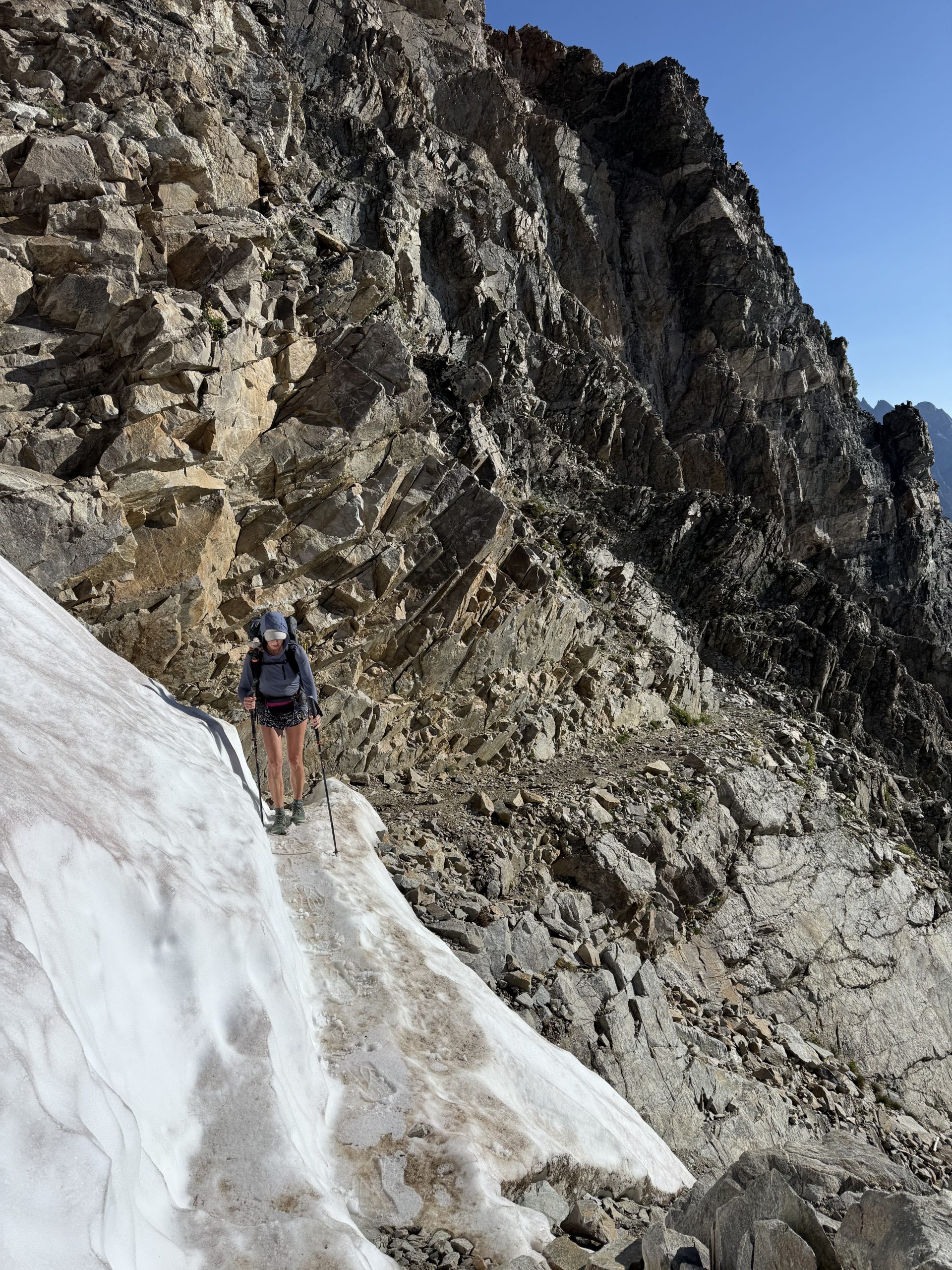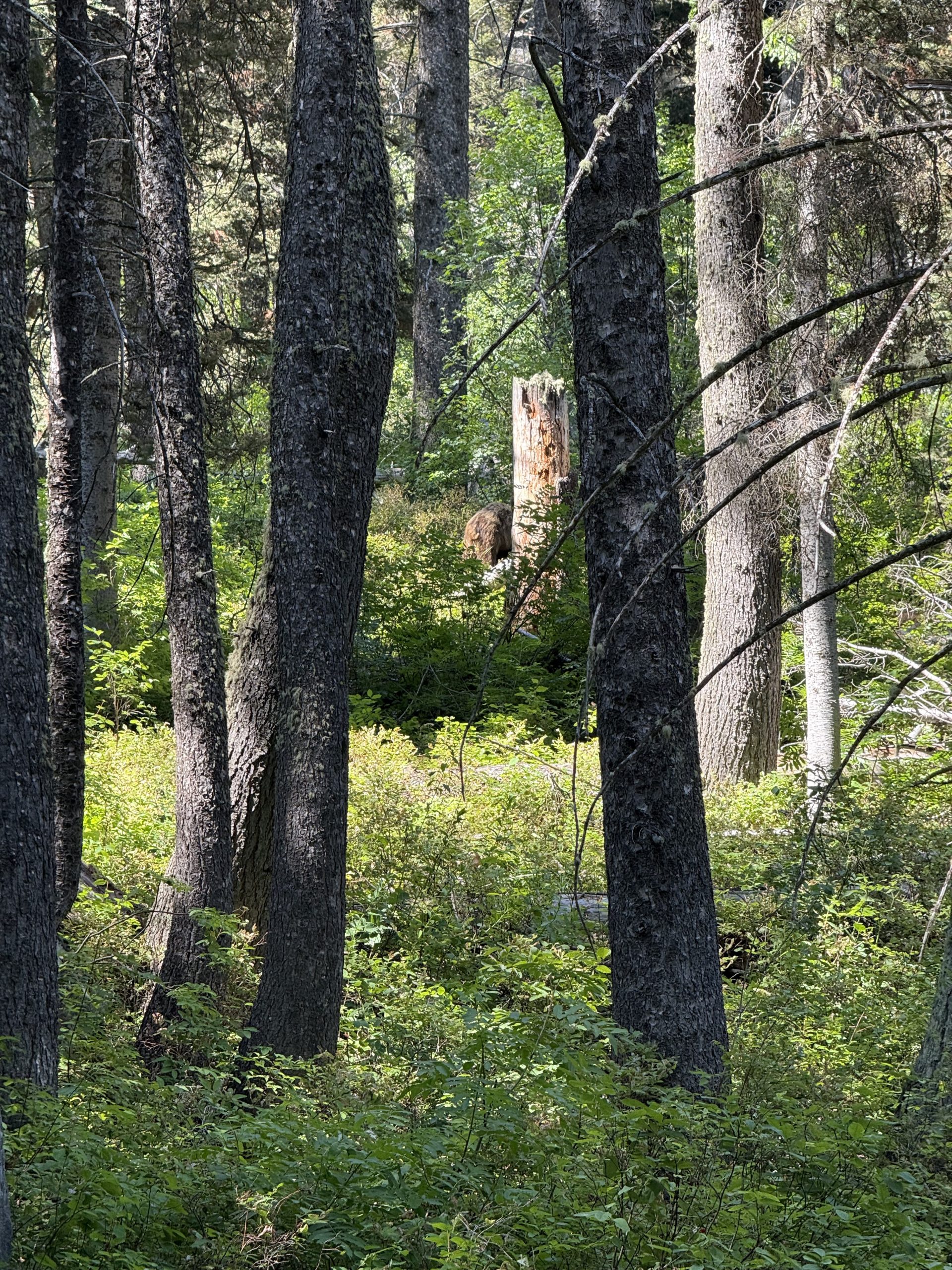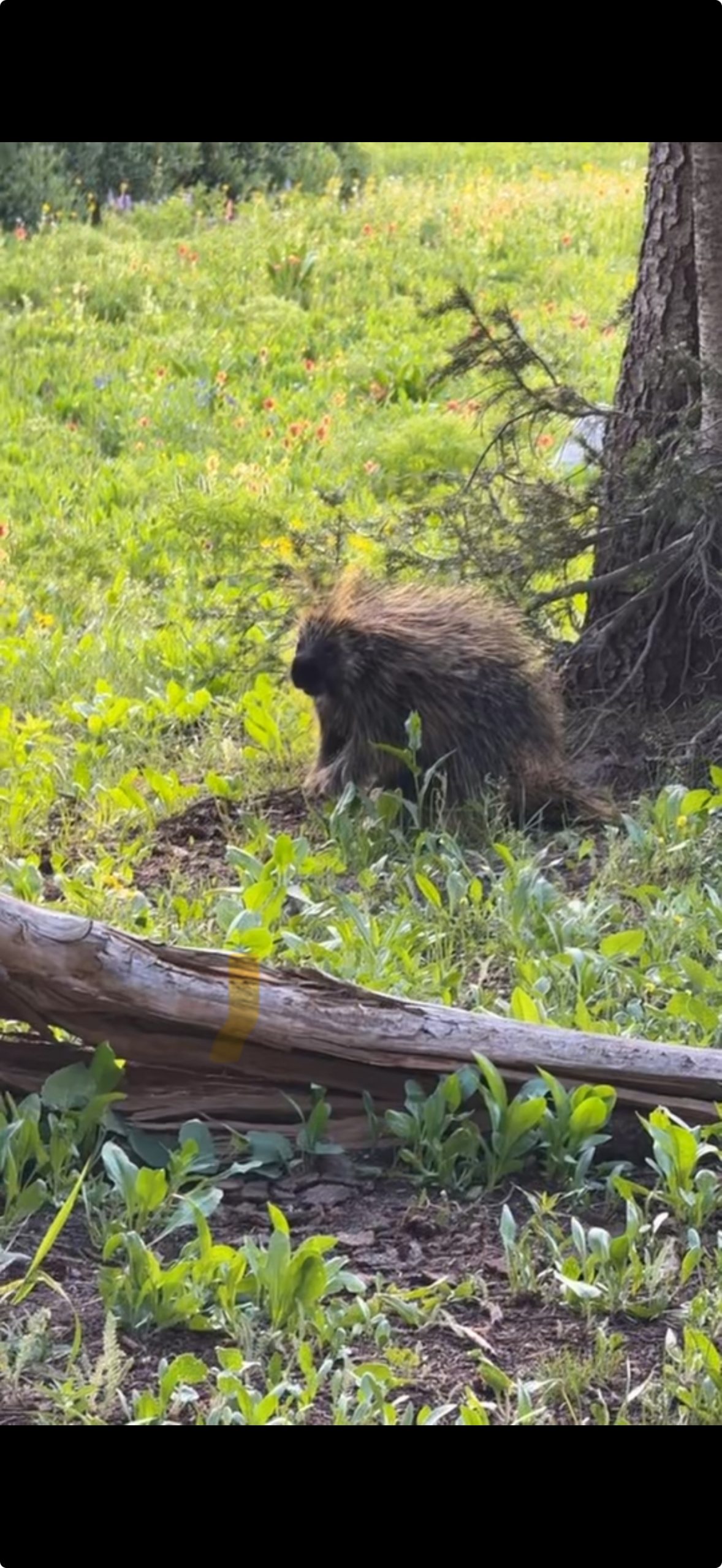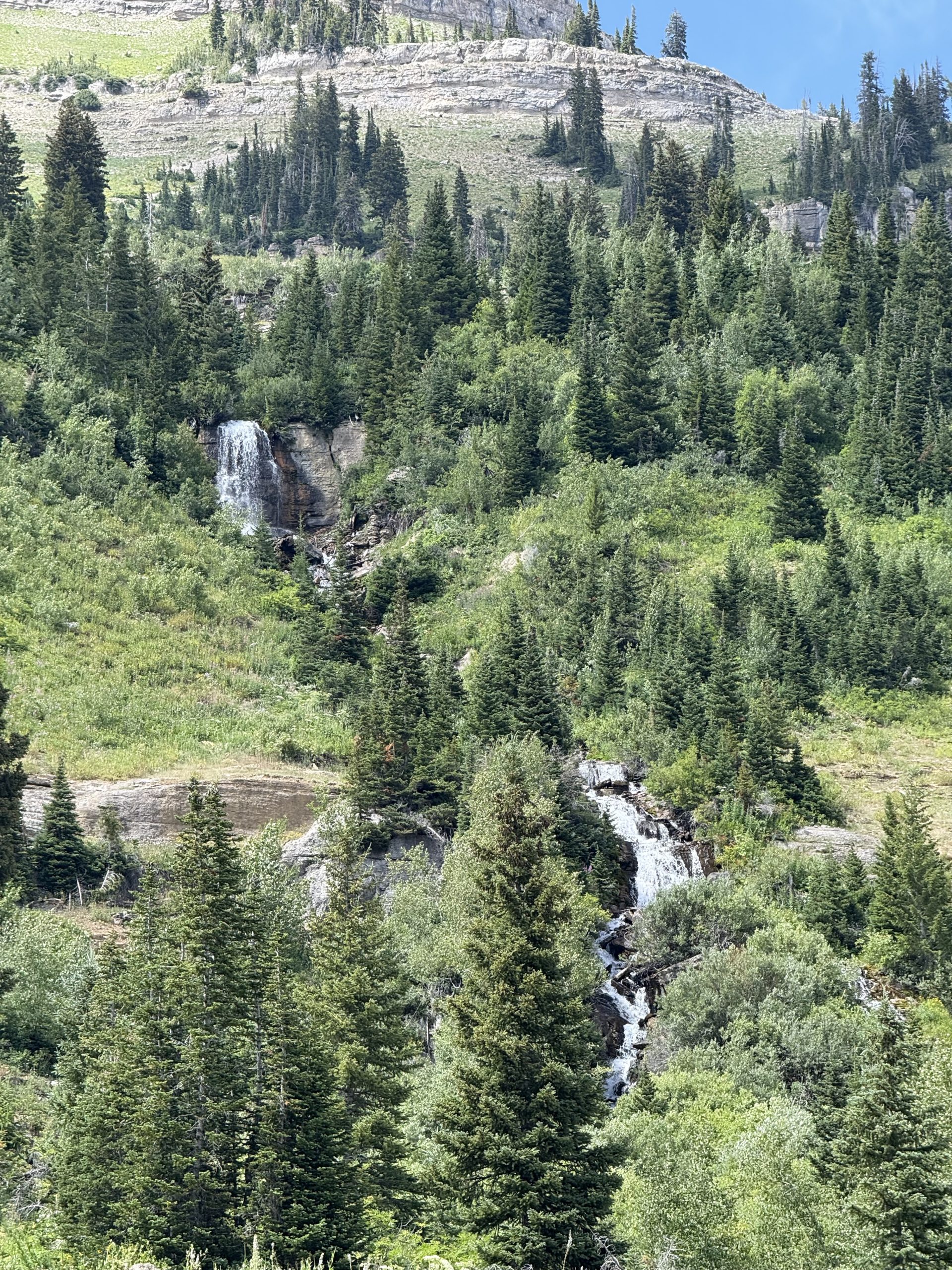8 Wonders Trail: Wonder # 5 Grand Teton National Park
Excitement filled the air in every direction. Lambchop and I sat snacking, eyes glued to the towering features before us—rock stretching far into the sky, jagged and yet soft, inviting. Beckoning us to come explore its vastness. Grand Teton National Park was calling, and we couldn’t wait to answer.
The last few days before entering the park were filled with planning and gathering new supplies we’d need. A bear-proof container and bear spray, now securely packed into our backpacks, reminded us not only of the adventure ahead but also that we were no longer at the top of the food chain.
Jenny Lake, Grand Teton National Park
It always surprises me how quickly the crowds disappear once you head into the backcountry of a national park. One moment, you’re surrounded by mobs of tourists; the next, the trail is yours alone. As we circled Jenny Lake and began our first big climb, it started to feel like we had the place to ourselves. Within just a few miles, the noise and bustle below were forgotten. We had arrived.
⸻
A Stormy Start
Our first day, though mostly uphill, went by quickly. Every switchback revealed a new view, and I could hardly keep my phone in my pocket—I wanted to capture every bit of the awe-inspiring landscape surrounding us.
As we climbed higher into the mountains, the air began to change.
“It feels different up here,” Lambchop said. “You can feel the humidity building.”
She was right. The moisture in the air matched the forecast we’d seen—rain was coming. It felt like Mother Nature was about to wring the sky out like a wet sponge.
“We’d better keep moving. It’d be nice to get set up before it hits,” she added as we made our way toward our campsite at Holly Lake.
We pulled into camp just in time. The first drops were falling as we hurried to set up our shelters. Thunder rumbled in the distance as we put the final touches on camp.
Not wanting to eat in the downpour, Lambchop climbed into her tent, and I tucked myself under a thick pine tree to ride it out. According to the forecast, the storm would pass soon.
“Let’s reconvene when the rain stops and have dinner then,” Lambchop called out. She nearly had to yell to be heard over the crashing thunder and intensifying rain.
Two hours in, I was beginning to doubt we’d be eating at all. Everything was soaked, and the rain didn’t look like it would let up anytime soon. The show Mother Nature put on was humbling—lightning, thunder, and a relentless downpour. The ground, now saturated, couldn’t absorb another drop.
Suddenly, Lambchop burst out of her tent. A lake had formed around her setup, and water was starting to seep inside. We spent the next 30 minutes digging trenches, doing our best to drain the floodwaters away from our shelters.
“For a minute there, I thought you were going to float away,” I joked, returning to my mostly dry perch beneath the pines.
After three hours, the clouds finally began to lighten. The rain slowed to a steady drizzle, and though thunder still rumbled in the distance, we had a small window.
“I think this is our chance,” I said, gathering my cooking gear. “We’d better eat while we can.”
We moved quickly, finding a spot about a hundred yards from camp to cook—far enough to keep the smell of our food from drawing any unwanted visitors. The break didn’t last long. Before we were even done eating, the rain returned. We scarfed down the last bites and rushed back to shelter.
Back under my tarp, belly full, thunder still echoing in the distance, I drifted off to sleep—hoping the trenches we’d dug would be enough to keep the worst of the water flowing away.
The next morning we woke up to an amazing scene. As the sun rise peeked over the Eastern horizon and the light bounced off of a huge cirque to the west as moisture from last nights rains began to form into low level clouds suspended in beautiful harmony with the background. I finished my morning coffee and we packed up our wet gear.

The morning after the storm
A mellow anxiety began to rise when I remembered what laid ahead. Paintbrush divide, a high mountain pass that holds snow deep into the summer was in our sights. We had been assured by the park rangers we had talked to that the worst of it had melted and because of this we ended up leaving our traction devices back in Jackson. Did we need them? I wasn’t sure yet but I sure hope we didn’t. As we moved up the mountain towards the pass small patches of snow near the trail made me feel like maybe we had made the wrong choice. But as we scrambled up the rocks and the divide came into view anxiety was replaced with relief and jaw dropping trail. The majority of the snow cornice we had seen pictures of just a few days ago had melted into a 15 foot snow crossing that I was confident with a little care could be easily crossed.
“We sure have been timing the snow melt perfectly.” We both agreed.

Lambchop crossing Paintbrush Divide
The way down the pass met with Solitude lake. One of the many prized sights in Grand Tetons backcountry. Once down off the pass we took a much deserved break on a rock outcrop on the lake with walls of steep landscape surrounding us.
“We had better get going.” Lambchop said getting up from her spot near the water. “Our stuff is soaked and we should get to a good place to have lunch and set our stuff out to dry.”
We set off down the steep grade crossing over a few patches of snow that to be honest were a little sketchier than the feared Paintbrush Divide. But as we lowered our elevation the snow was quickly in our memories and the warmth returned reminding us it was truly summer. We passed quite a few day hikers and a few overnighters heading up to Solitude Lake and soon found ourselves a spot in the sun to set up our hiker trash yard sale. A funny term coined by hikers when you sprawl all of your things out to dry. We enjoyed a long lunch, watched as a couple groups on horseback passed us, packed up, and continued our journey.
Our First Grizzly Encounter
Over the next day and a half, the trail led us through some of the most jaw-dropping landscapes I’ve ever experienced. We weaved in and out of Grand Teton National Park and the Jedediah Smith Wilderness, and honestly, I couldn’t pick a favorite stretch—it was all stunning.
We made one final crossover back into the park and dropped into Granite Canyon for a longish descent toward Teton Village.
As we sat at the junction for Granite Canyon, a big family out on a day hike passed by. Each of them had a small backpack… with a full-size lawn chair strapped to it. It struck me as… funny, me, hauling 30 pounds of gear, finding that absurd. Ha!
They chatted as they passed, and I overheard one of them say, “That’s the canyon where we saw the bear,” pointing directly down the route we were about to take.
We’d been staying bear-aware as we made our way north into the Tetons, but aside from a few ancient piles of scat, we hadn’t seen much sign. This comment, though, shifted something in my gut. I felt my senses heighten—every stump or shadow that was remotely bear-colored made my eyes lock on, only to discover it was, once again, just a pile of dead branches.
We didn’t see another hiker until about three miles from the trailhead.
“Wow, didn’t think we were going to see anyone else today,” Lambchop said as a few people walked up.
We chatted briefly about where we’d come from, where they were headed. Normal hiker chat. Just as we were saying goodbye, one of them added casually, “We just saw a bear, maybe 20 yards off trail. Just a half-mile back. Be careful.”
“Maybe you should go first,” Lambchop said, half-joking, as I silently checked my reach to the bear spray tucked in one of my side pockets on my backpack.
Every bear encounter I’ve ever had has been a positive one, but each one is different. There’s no guarantee how a bear will respond to seeing you. It was encouraging that the last group had no trouble, but that didn’t mean we’d get the same outcome.
The next half-mile went by in a snap. And then… there it was.
“There’s the bear, right there,” I said, pointing dead ahead, just left of the trail. “Hey bear! Over here, bear!”
The adolescent grizzly immediately started moving away from us to the left, not in a rush but clearly not interested in a confrontation either. It never really turned to look at us. Fear turned into relief and excitement.
As it moved to a more comfortable distance, we cautiously continued down the trail.
“Hey bear,” I called again—calm, firm, steady.
The trail turned left, putting us slightly downhill and about 45 yards below the bear.
“Over here, bear!” Lambchop added, echoing the call. Equally confident as the bear continued to move away.
With its backside now facing us and the distance widening, I felt safe enough to pull out my phone and snap a few photos as it disappeared into the forest. We continued at a pretty good pace until we felt we were out of harms way.

The bear moving into the forest
Two and a half miles later, the dense forest opened up into the Jackson Hole valley. We took a right at the park boundary and followed the paved road about three miles into Teton Village. There, we hopped on a shuttle bus into Jackson, and by the time we checked into our hostel, we were more than ready to collapse—physically, mentally, and emotionally—from our first chapter in the Tetons.
A Visitor in the Night
After a day spent relaxing and doing hiker chores in Jackson, Wyoming, we were both eager to get back on the Teton Crest Trail. We made our way back to Teton Village and took the tram at the ski resort back up to the top. The easiest 4,165-foot climb I’ve ever done!
After a mellow 6.3-mile afternoon, we arrived at Marion Lake, our home for the night high in the mountains of Grand Teton National Park. We set up on designated tent pads, so far, the first ones we’d seen in the park. After dinner and a few rounds of Yahtzee, we called it a night, and before long, I was sleeping soundly under my tarp.
“Scratch, scratch… crinkle, crinkle…”
I started to stir, caught somewhere between a dream and half-consciousness. Then again—scratch, crinkle. And again.
Slowly, I surfaced back to full awareness.
Yep… I’m definitely hearing something.
The sound was close—very close. Finally, I called out in Lambchop’s general direction, “What are you doing over there?”
I figured maybe something had gone wrong with her sleeping pad or tent and she was trying to fix it.
“Huh? What do you mean, what am I doing?” Lambchop mumbled, clearly having been sound asleep.
In that instant, I knew.
I rolled over and yelled as loud as I could muster, “HEY! GET OUTTA HERE! GET! YOU HEARD ME—GO!”
Frantically, I reached for my headlamp to get a look at whatever had just been inside my tarp.
“Damn it!”
I couldn’t find it. Then I remembered—I’d left it on the far side of my sleeping pad. I rolled fast and grabbed it, clicked it on, and swept the beam around camp.
Back and forth. Searching.
Nothing.
After what felt like forever—but probably wasn’t more than a minute or two—Lambchop, now more awake, asked, “What the hell is going on?”
“I think I had a bear reaching into my tent!” I said.
“Are you sure it was a bear?” she asked, now fully alert.
“Well… no,” I admitted. “It was dark, I had just woken up, and I couldn’t find my headlamp. But it was big, and it was basically inside my tarp with me.”
I paused. “Could’ve been anything, I guess…”
After a long while and a lot of imagining grizzlies crashing through my flimsy shelter, I finally began to doze off again.
Then—
“Scratch, scratch…”
This time I was ready. In one swift motion, I clicked on the headlamp and flipped toward the sound.
“GET OUT OF HERE, I SAID! GO!” I yelled—way more forcefully than before.
If a bear was going to eat me, it was at least going to know who I was.
But when I stopped yelling and focused on what was in front of me… I froze.
Right there inside my tarp—close enough to touch—was the biggest porcupine I have ever seen. Its quills flared in a wild, defensive wave down its back. Clearly just as surprised as I was, it began backing away, quills still raised, pausing every few steps to make sure I wasn’t coming after it. It sulked slowly into the bushes, and eventually, I couldn’t hear it anymore.
“What was it? Did you see it this time?” Lambchop asked. She sounded like she hadn’t slept at all since the first round.
“It was the biggest porcupine I’ve ever seen. And it was in my tarp. Right on my tent pad,” I said. “I think I scared it away this time.”
“Were its quills out?”
“Not while it was under the tarp, thankfully. But the second time, it was way closer. One wrong move and I probably would’ve been in pain, to say the least.”
“Hopefully I scared it off for good,” I added, though doubt was thick in my voice.
“It’s probably after the salt on your backpack,” Lambchop offered. She told a quick story about a porcupine that once tried to steal something sweaty.
We didn’t sleep much after that. Sometime later, the porcupine came back again—one more short-lived encounter—and then finally, the rest of the night was quiet.
Eventually, the sun rose. We packed up camp and walked over to where we’d stashed our bear cans. I fired up my stove and made breakfast and much-needed coffee.
“Look!” I said, pointing about 20 yards away. “It’s that porcupine!”
Lambchop couldn’t resist. She grabbed her phone and started filming immediately.
“This is the porcupine that was harassing Unity last night…”

The Visitor in the night
Off-Trail Travel
After leaving Marion Lake and passing into the northern stretch of the Teton Crest Trail, we were met with a couple of days of thickly overgrown trail that seemed to either go straight up or straight down. The wildlife, however, had somehow morphed into much cuter and far less dangerous creatures. Pika and marmots actually seemed to greet us—and at times, they looked like they were enjoying the scenery just as much as we were.
Somewhere along our second day, we crossed paths with a couple of locals out exploring some of their favorite parts of the trail. We made small talk, which inevitably turned into a discussion of what route we were taking to exit the park.
“You probably don’t want to go that way,” one of them said. “It’s super overgrown, and the trail’s in pretty rough shape.”
We’d already heard this kind of thing a few times along the way—tales of disappearing trail, impassable brush, and hikers having to hold their phones out the entire time just to follow a GPS line.
Lambchop cut in while he continued, “Well, you’re from around here. What route would you suggest?”
They told us about an alternate route that would take us up and around the peak of Moose Mountain. From there, we’d be met with a beautiful pass and, hopefully, a clear route back down to where we wanted to be.
“There’s a bit of bushwhacking,” they added, “but the route’s easy enough to follow.”
After they showed us the area on our map and
wished us luck, Lambchop and I were left with a decision. It didn’t take long. The alternate route sounded a whole lot better—and when a local hiker tells you it’s amazing, the risk of failure seems a lot smaller.
At the bottom of Moose Mountain, we stopped and surveyed the area.
“This is the point on the map where it says it goes up,” I said as Lambchop caught up behind me.
We picked a few landmarks to aim for and started up the steep, unmaintained slope—taking breaks, recalculating the easiest line, and scrambling when we had to. Just when my legs were burning and my breath was at its heaviest, the terrain began to level out.
We made our way toward a marker called Horse Thief Pass.
This—this is why I do this. To explore places few people go. To sit in vast, remote spaces where you can feel the presence of others long gone—other humans who may have sat in that same spot, overcome by the same awe and wonder. It’s a powerful feeling, one that connects you across time and space.
We took a long break at a National Park boundary sign and snapped some pictures, then began our descent into Moose Basin. The wildflowers were in full bloom and lush green grass surrounded us. We picked our route down the gently sloping, plateaued meadow—no trail, no cairns, just natural beauty in every direction.

A huge waterfall we passed coming down Moose Basin
With permission from the resident rangers, we spent our final night in Grand Teton National Park near a patrol cabin close to Jackson Lake.
“Thank you so much!” Lambchop said as one of the rangers gave us the okay. “We really didn’t want to hike the last few miles out of the park tonight.”
“Thanks again,” I added as I picked up my pack and walked off to set up camp.
Our time in the Tetons reminded me how quickly everything can change—sometimes in a few miles, sometimes in a single moment. One minute you’re walking through alpine silence, the next you’re soaked in a storm, face-to-face with a grizzly, or yelling at a porcupine inside your tarp. Every soaked tent, bear encounter, off-trail climb, and midnight standoff was a reminder of why I hike: to feel small, alive, alert. To sit on a ridgeline and wonder who else has sat there, awestruck. To lose the trail and find something better.
That final morning by Jackson Lake, I wasn’t ready to leave. But the trail ahead—Yellowstone—is calling. New miles. New stories. Just around the bend.




